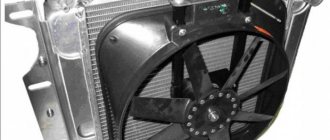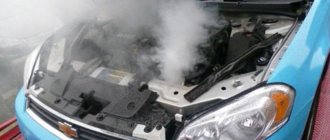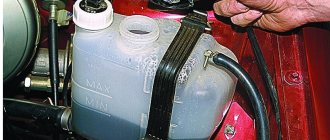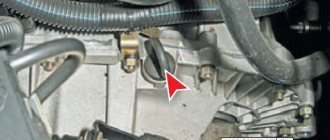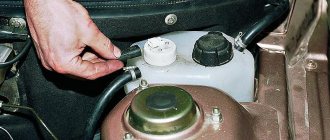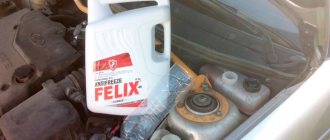It’s stupid to say that the engine in a car gets very hot during operation. This process is hindered by the same antifreeze that many people pour into the tank just because they “have to,” without bothering to find out the details of the process.
The performance of the cooling system depends on the quality of the coolant. An important parameter is the level of antifreeze in the expansion tank, which will be discussed later. What can happen if you reach critical high and low marks? How to provide the optimal amount of fluid and monitor its condition? Let's talk about this.
Antifreeze level in the expansion tank VAZ 2110 16 valves
Lada VAZ-2110 (2111, 2112).
CHECKING THE LEVEL AND ADDING COOLANT The manufacturer recommends using original coolant.
Do not mix liquids of different colors and different manufacturers. If you need to add coolant, but you do not know the brand of coolant in the system, replace all coolant in the cooling system. Use products only from trusted manufacturers. Remember that using low-quality coolant leads to expensive engine repairs! Before starting work, place the vehicle on a level surface.
Check the coolant level only when the engine is cold. Coolant is toxic, so take precautions when working with it.
Do not pour fluid into the reservoir above the “MAX” mark, as its volume will increase when the engine is running.
When starting the engine, the expansion tank and radiator caps must be closed.
Constantly monitor the coolant level. Its sharp decrease or increase should be a signal for an immediate check of the engine cooling system. If freshly poured antifreeze suddenly unexpectedly quickly changes color to brown, it means that you were sold a fake, in which they “forgot” to add corrosion inhibitors. Replace the fluid as quickly as possible before it has time to corrode the cooling system elements.
1. Check the coolant level. It should be between the “MAX” and “MI N” marks marked on the wall of the expansion tank.
2. To add fluid, unscrew the cap of the expansion tank.
. and add coolant to the “MAX” mark.
4. Close the expansion tank cap.
If the expansion tank is completely empty, press the filler cap of the radiator of the engine cooling system and turn it counterclockwise.
Add coolant to the edge of the filler neck. Then close the neck with a stopper.
Add coolant to the expansion tank to the required level (see above).
Screw the filler cap of the radiator of the engine cooling system tightly. When the engine is running, the cooling system is under pressure, so coolant may leak from under a loose plug or the plug may break off.
There are two valves installed in the radiator cap: intake A and exhaust B. The exhaust valve plays a big role in ensuring optimal engine temperature conditions. It maintains an excess pressure in the system of at least 0.08-0.10 MPa (0.8-1.0 kgf/cm2), ensuring an increase in the temperature at which the coolant begins to boil and preventing intense vaporization.
When the valve jams in the closed position due to overheating, a significant excess of excess pressure occurs - more than 0.2 MPa (2 kgf/cm 2), which can lead to damage to the radiator or failure of one of the hoses. In turn, jamming of the valve in the open position leads to premature boiling of the coolant.
Therefore, wash the radiator cap with running water once a year. If in doubt, replace the plug. Obviously, if you remove the radiator cap on an overheated engine and this action coincides with thermal shock, then boiling of the liquid and the formation of air pockets in the cooling system will be guaranteed.
Source
Preparing for replacement
Many people are interested in how many liters of coolant are in a VAZ 2110 car, how much of it can actually be drained, and how much should be bought to replace it?
The so-called antifreeze filling volume is 7.8 liters. In reality, it is impossible to drain less than 7 liters. Therefore, for the replacement to be successful, it is enough to buy about 7 liters.
It is very important to adhere to several rules:
To change antifreeze, you must first drain the old one:
If it is a carburetor, also remove the hose at the junction with the fitting for heating the carburetor. It is these actions that are necessary to prevent air jams from forming.
After the replacement is made, you need to tighten the expansion tank cap tightly (this is important!). Return the removed hose to its place, reconnect the ignition module, return the removed wire to the battery, and you can turn on the engine. Let him work a little.
Sometimes the coolant level in the tank drops. This means that there was a plug somewhere, and it “pressed through” (you checked the fastening of all the hoses!). You just need to add antifreeze to the optimal volume.
Source
Level of expansion tank VAZ 2110
It’s stupid to say that the engine in a car gets very hot during operation. This process is hindered by the same antifreeze that many people pour into the tank just because they “have to,” without bothering to find out the details of the process.
The performance of the cooling system depends on the quality of the coolant. An important parameter is the level of antifreeze in the expansion tank, which will be discussed later. What can happen if you reach critical high and low marks? How to provide the optimal amount of fluid and monitor its condition? Let's talk about this.
Dismantling and replacing the tank on the “ten”
To replace the device, you will need to drain the coolant if it has not leaked out before. The expansion tank VAZ-2110 is dismantled as follows:
- Disconnect the negative cable from the battery.
- Disconnect the wire from the refrigerant level sensor.
- Using a Phillips-head screwdriver, unscrew the screws on the clamps of all hoses, loosening them.
- Disconnect all hoses going to the tank.
- Unfasten the rubber strap securing the tank and remove it.
Installing a new device is carried out in the reverse order. Don't forget to add coolant to the correct level!
What causes the antifreeze level to decrease?
The coolant level is affected by a list of factors:
- integrity of the cylinder head, gaskets, block, radiator and hoses, heater and expansion tank;
- fixing all system hoses with clamps;
- full operation of valves;
- general condition of fluid drainage from the hose and neck;
- operation of the fuel supply system;
- correct setting of the ignition system;
- type of antifreeze;
- driving style.
When cracks appear in the cylinder head or gaskets, antifreeze gradually leaks into the oil or cylinders. In the first case, the driver will receive a bubbly composition that is not suitable for further use in the system. In the second, the exhaust will take on the appearance of white steam even in warm weather. Punching the gasket is fraught with the appearance of two symptoms at the same time.
Additionally, there is a noticeable decrease in power output, which leads to increased gasoline consumption. Loosely secured hoses can leak antifreeze when high pressure in the system is reached. Failure of the radiator valves and expansion tank will prevent normal pressure from forming, which will lower the boiling point of the coolant and create the risk of vapor locks, which will greatly affect the integrity of the cylinder head.
Clogging of the exhaust hoses with slag may prevent the antifreeze from returning back to the radiator and engine. As a result, the acceptable level will drop, which will become the basis for the formation of new traffic jams.
Several factors also influence cylinder heating. And this is not only the operation of the cooling system, but also the competent adjustment of the fuel equipment itself, as well as the ignition system. If an over-lean mixture enters the system, detonation will occur, which can lead to faster combustion of gasoline with increased heat release. This leads to an increase in the temperature of the antifreeze, boiling and the appearance of traffic jams. As a result, we have a sharp drop in the coolant level and accelerated overheating of the engine.
If the fuel mixture is too rich, you will have to step on the gas harder to ensure proper power. In this case, the cylinders are overfilled with gasoline, which leads to a drop in the level of antifreeze and boiling of the system as a whole.
What's better?
First, let's figure out what to choose for your car. After all, no one wants to repair a car often, but on the contrary - once it’s done well and forgotten about the problem for a long time. Let's immediately note one thing - antifreeze is the name of a certain antifreeze. Antifreeze was developed in Russia for domestic cars. It is universal for locally produced cars, but is not used in foreign cars.
Antifreeze
- Antifreeze is produced using traditional technologies, which are already noticeably outdated.
- Such technologies allow the formation of a protective layer on the walls of cooling jackets up to 0.5 mm thick during operation. And considering the thickness of the shirts themselves, this is not so little!
- This very layer has low thermal conductivity, and therefore heat transfer. It turns out that the cooling system has to work longer at elevated temperatures.
- This leads to increased wear of unit parts, as well as increased gasoline consumption. Sediment can also cause the thermostat to jam.
- The advantage of antifreeze over other antifreezes is its price! It's much smaller!
- On the other hand, antifreeze is quite common in our area. It is widely used at technical stations. service by many masters.
- Taking into account the wear of engine parts and other possible breakdowns, we can say that antifreeze fully justifies itself as a coolant.
- Usually replaced after 30-40 thousand kilometers or 1 year of use of the car.
Antifreeze
- Antifreezes are usually considered a better coolant option than domestic antifreeze.
- Different colors of antifreeze indicate its different composition, the presence of additional additives and, accordingly, different temperature conditions in which its operation is allowed.
- The best efficiency is about antifreeze. They do not form a protective layer along the entire wall of the shirt. The protective film is formed only in places of metal corrosion and reaches a thickness 100 times less than the antifreeze film.
- Various additives can increase the service life of antifreeze up to 250 thousand kilometers, and standard antifreeze with a minimum of additives or without them can last up to 100 thousand kilometers.
Based on the above information, we draw conclusions. Replacing antifreeze on a VAZ 2112 requires high-quality fluid. Antifreeze is better than antifreeze.
Remember! It is recommended to use the brand of antifreeze recommended by the manufacturers.
How to check the coolant level?
To achieve optimal compression and proper engine cooling, you need to periodically look at the expansion tank indicator. But how to check the antifreeze level yourself? The procedure has several stages:
- Unscrew the radiator cap with the engine off. In this case, the liquid should be at the lower level of the outlet, from which the hose goes to the tank.
- We inspect the tank. Antifreeze is between the “Min” and “Max” indicators.
- If the level is less than required, add what is missing, then warm up the car to operating temperatures (90-95 degrees) and cool to room temperature. A drop in the level in the radiator or tank indicates a seal failure, which means the engine needs serious repairs. If the level remains normal, everything is fine.
The check should be carried out at least once a week, especially on cars with high mileage. Diagnostics allows you to timely notice a drop in antifreeze in the system and indirectly determine the cause of the malfunction. You will also save significantly on power repairs, and major repairs, as we know, are very expensive.
Every VAZ-2110 owner, at least once in his life, has encountered a problem when antifreeze pours out of the expansion tank. Some already know how to behave in such a situation, but for some it is difficult. What to do in such a situation? This will be discussed later in the article.
You may also be interested
Why the interior may smell like antifreeze: several serious reasons
Many motorists have encountered the unpleasant situation of smelling antifreeze in their car. Why is this happening? How dangerous is the situation for the car and its owner, how to fix the problem? Let's talk to the experts.
How does antifreeze get into the engine?
Among the malfunctions that can happen to a car, one of the most common is antifreeze getting into the internal combustion engine. If oil gets into the antifreeze, you should also immediately diagnose and eliminate the cause of the breakdown. This will avoid major repairs to the machine and minimize damage.
Cooling system
To understand how to deal with the problem, you need to know how the cooling system in a car works.
Antifreeze is a chemical-based liquid that prevents the engine from heating up in the summer and prevents the radiator and block from freezing in the winter. It turns out that antifreeze is designed to protect the engine from its critical temperature.
The special composition of this liquid ensures that it can boil at a higher temperature than ordinary water . Depending on the type of motor and brand of liquid, the boiling point is on average 110 degrees. There are also mixtures that can boil at a temperature of 200 degrees.
If the cooling system of the car is working correctly, then the antifreeze does not boil and is not squeezed out of the tank. This also ensures normal engine operation. At the same time, antifreeze does not destroy metal and plastic, and therefore it can be considered safe for cars.
Antifreeze is filled through the tank, which then enters the cooling system. The liquid may heat up during circulation, resulting in steam. Usually it passes through a special hole in the tank lid. Also, through such a hole, excess antifreeze in the system is released.
First of all
Try replacing the cover with a new one or using a known working one for the duration of the test.
Notice how much the tank swells. If it is not significant and it is clear that it is not due to excess pressure, and you are the owner of a VAZ 2110-12, then you should not worry too much, since this is considered the norm for such cars.
The fact is that new tanks for such cars have a finless design and are made of plastic, which does not hold its shape very well, so over time they begin to swell.
Expansion tanks from Lanos, Priora, Nexia have proven themselves well; they are often installed instead of VAZ ones.
If the tank swells strongly and ruptures, even after replacing it along with the lid, then pay attention to the following points:
- Does the coolant boil?
- What color is the oil in the engine crankcase?
- Are there gases from the combustion chamber in the tank?
- What is the pressure in the cooling system;
- The quality of the tank itself.
Reasons for leaks
Coolant leaks around the expansion tank cap.
There are many reasons why antifreeze can leak from the VAZ-2110 tank. If the car is operated correctly, then usually a leak can occur due to wear and tear on system elements.
- The system has rubber pipes, which, despite its density and resistance to aggressive environments, can last a long time, but in the process it wears out and ages.
- In this case, cracks are formed, which lead to air entering the system.
- Also, some of the antifreeze may be lost through cracks, and therefore this leads to overheating of the engine.
- At high temperatures, high pressure arises in the system, which pushes the liquid out through the plug on the tank.
Plugs or tanks
If the expansion tank on a VAZ-2110 was replaced, then the cause of the antifreeze leak may be a poor-quality tank or plug, of which you can find many on the modern market. If there are chips on the thread, this will not ensure tightness, so the antifreeze will leak out.
The problem may be in the tank itself. When its walls are thin, they can burst when expanding. In this case, antifreeze leakage will also occur.
A crack in the tank made of low-quality plastic.
Thermostat and low amount of antifreeze
These may also be the reasons why the engine will overheat, antifreeze will boil and be squeezed out of the system under pressure.
A small amount of antifreeze will not be able to provide normal cooling to the engine, and therefore the temperature will constantly rise. a malfunction of the thermostat can cause the permissible temperature to be exceeded .
Detecting the cover malfunction
If you notice that the expansion tank in your VAZ-2110 is boiling at normal engine temperature, first check the cap. This can be done using a car compressor with a pressure gauge.
First, disconnect one of the upper thin hoses from the tank. We close its end tightly by bending it. This is necessary so that the coolant does not leak out when we create pressure in the tank. We connect the hose from the pump to the freed fitting and begin pumping. The lid must be tightly screwed on. When the pressure reaches 1.1 kgf/cm 2, listen to the plug. It should begin to hiss, indicating that it is working. If, when the pressure reaches 1.8 kgf/cm2, the lid does not begin to bleed air, you can safely throw it away. Otherwise, the tank will burst in the near future.
If the lid, on the contrary, begins to let air through before it should, throw it away. If the expansion tank in your VAZ-2110 is boiling, this is the reason.
Diagnostics
Since antifreeze can evaporate quickly, especially on a hot engine, this makes it difficult to identify the location of its leak . If a large amount of antifreeze leaks out, it is easier to spot the leak.
- When antifreeze leaks in the cabin, this indicates a malfunction of the stove. It needs to be changed. Faucets can also leak.
- When antifreeze enters the combustion chamber, it will cause water to appear on the exhaust pipe. The smoke will turn black . This will indicate that the gasket in the block is faulty.
- It is worth checking the tightness of the pipes. They need to be examined carefully, especially in the area of the tank. Often in a VAZ-2110 antifreeze can leak from the bottom of the tank where the pipe is attached.
All these moments can be accompanied by overheating of the engine and boiling of the liquid in the cooling system. Its temperature can usually be determined using a sensor on the instrument panel.
Consequences
If such problems with the cooling system are not corrected in a timely manner, this can lead to serious consequences. When antifreeze simply leaks out of the system, this will cause the engine to overheat and fail.
First of all, when the engine overheats, the gasket in the block will suffer. At high temperatures it can lose its properties and burn out. In this case, antifreeze will get into the oil, reducing and worsening its properties. This will affect the lubrication of parts rubbing against each other. They will quickly fail.
What should the engine operating temperature be?
Engine operating temperature shown on the instrument panel
If we take the information from the international convention of automobile manufacturers dated December 1, 1992, the uniform standard for engine operating temperature is considered to be 90 degrees Celsius. With such indicators, the engine operates as efficiently as possible and does not create residual negative effects.
When switching to more advanced engine manufacturing technologies in 2004, it was accepted that a specific indicator of this indicator cannot be held in one position, and therefore they made a gradation of acceptable standards, which amounted to 85-105 degrees Celsius.
Engine overheating shown on the instrument panel
According to data from the manufacturer AvtoVAZ, on a 16-valve VAZ-2112 engine, the operating temperature of the engine is considered to be 87-103 degrees Celsius.
At this temperature, all systems function normally, and the motor is not subject to negative factors and consequences.
Why does antifreeze come through the lid?
If the engine overheats or the expansion tank swells, many inexperienced drivers immediately run to open the lid and are very surprised, and many are frightened, by the antifreeze leaking out under pressure.
We will immediately reassure you - this is normal. The fact is that when the serviceable reservoir cap is closed, a pressure equal to 1.5-2.0 atmospheres is created in the cooling system. Moreover, we all know from physics that the boiling point of any liquid is directly proportional to the surrounding pressure. That is, the higher the pressure, the higher the boiling point.
Therefore, pressure above atmospheric pressure in the cooling system is created specifically so that antifreeze boils not at 100 C (1 atm.), but at 115 C (1.5 atm.) and 120 C (2 atm.).
After the engine is turned off and the lid is opened, the pressure equalization process occurs, the liquid flows from more to less, while it continues to expand, since the engine continues to gain temperature for some time, i.e. the point at which it begins to cool has not yet been passed.
If the antifreeze boils, it means the engine has overheated. In this situation, you do not need to open the lid right away, since the coolant may splash out on your hands and face under pressure - a burn is inevitable. Just in such a situation, when the tank cap is not working, the latter can swell.
Whoever had any life situations, write in the comments. And also ask questions.

